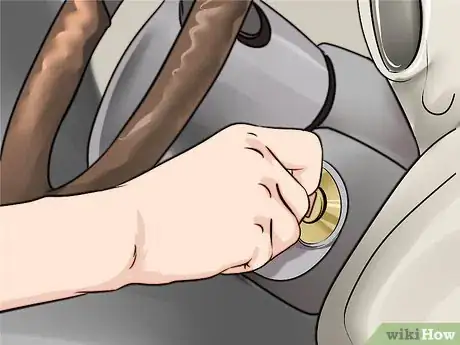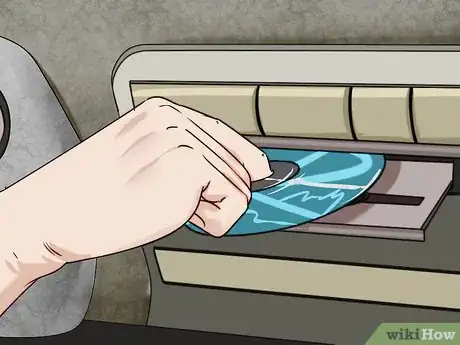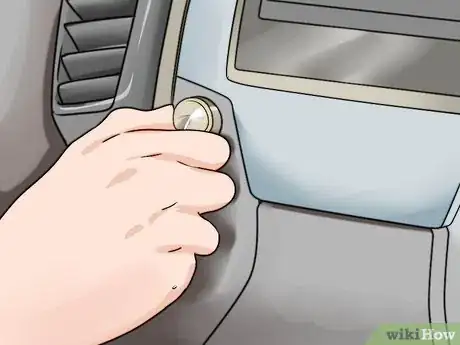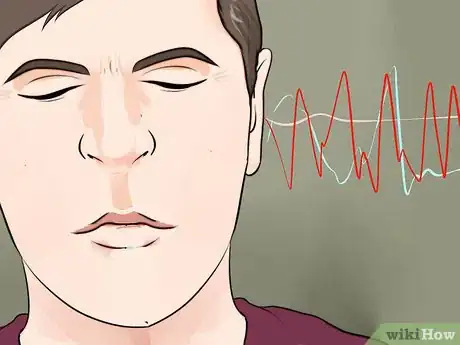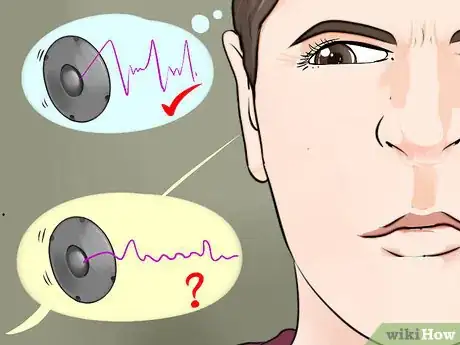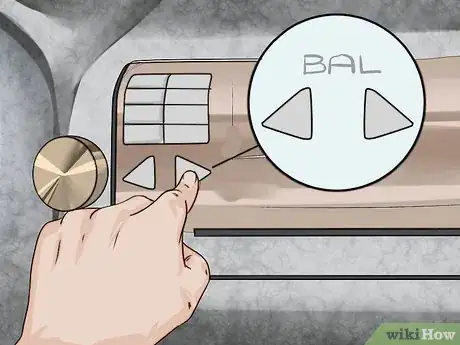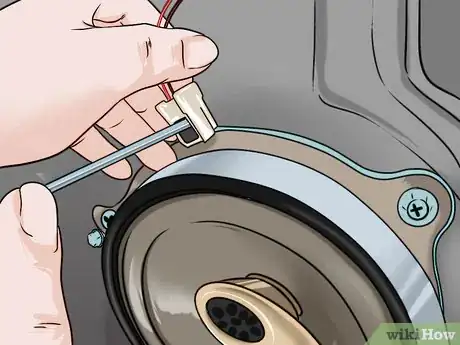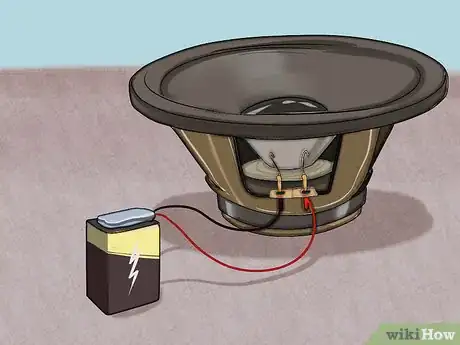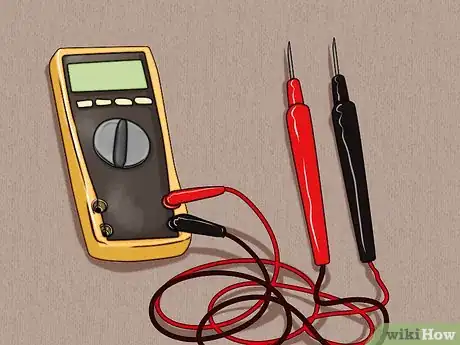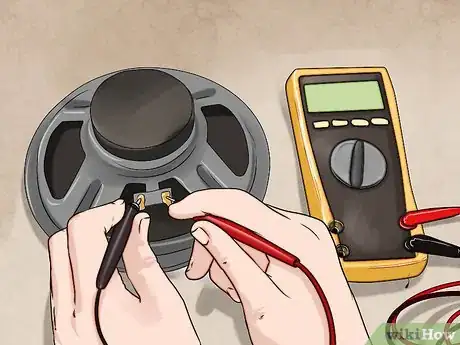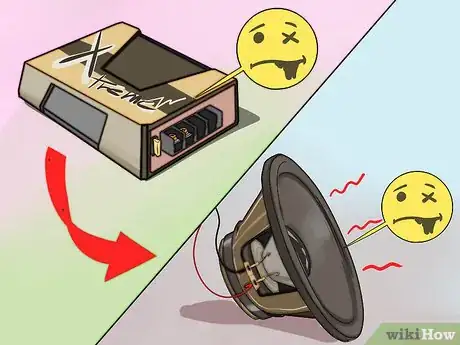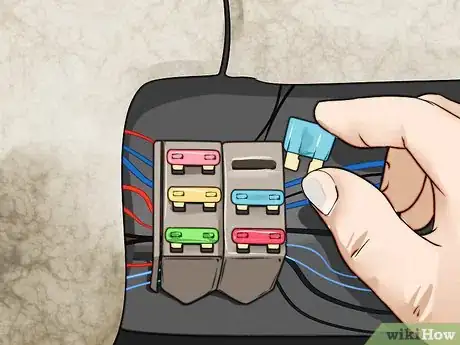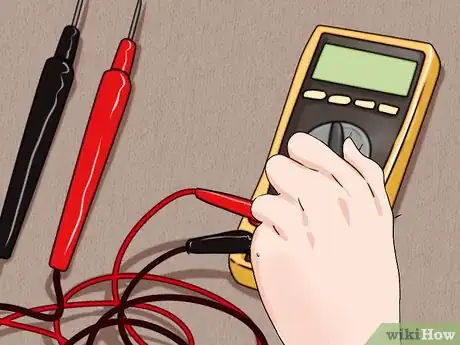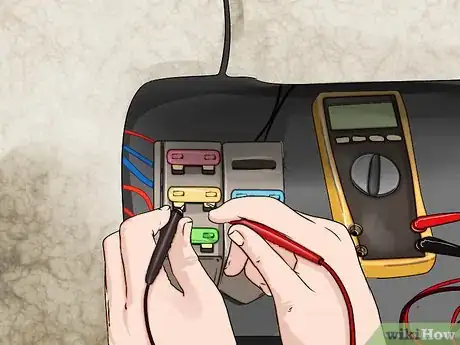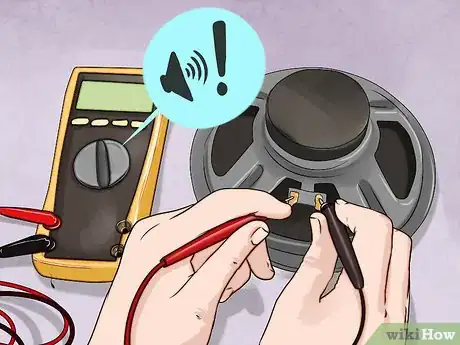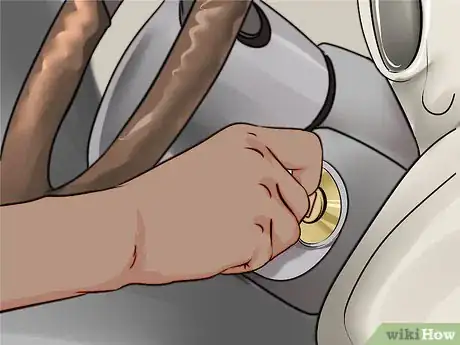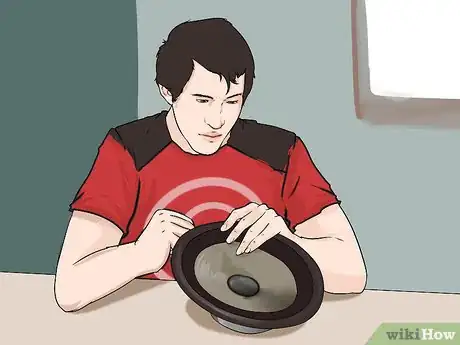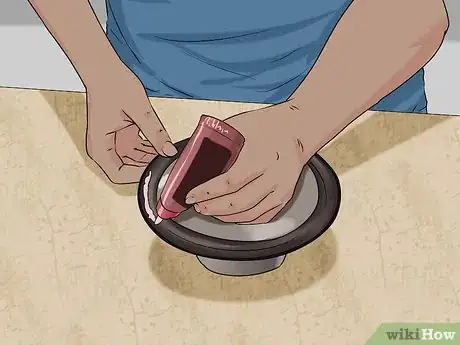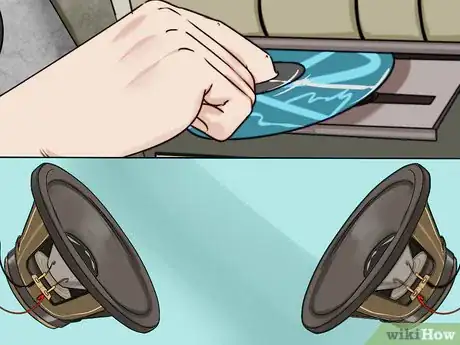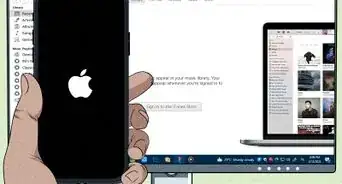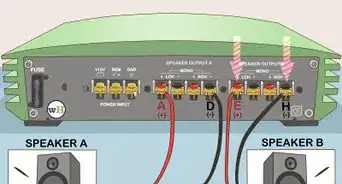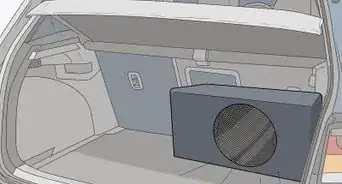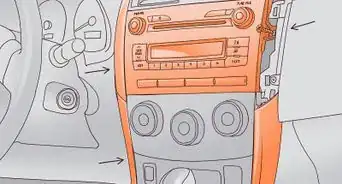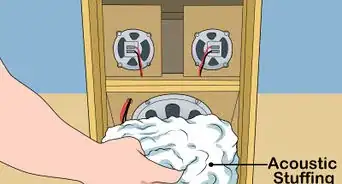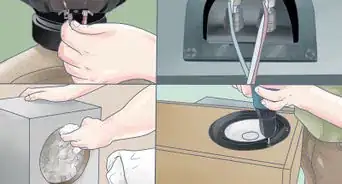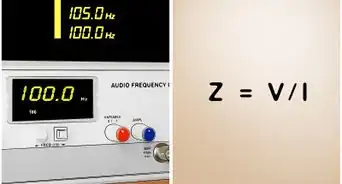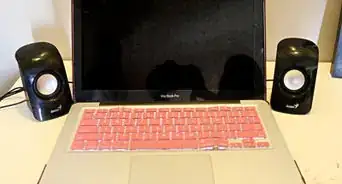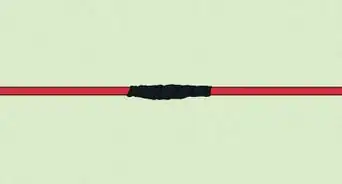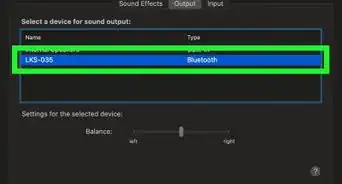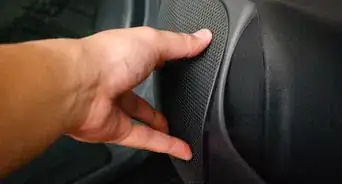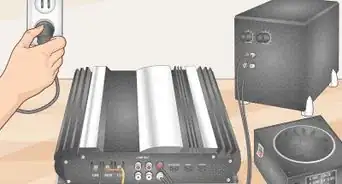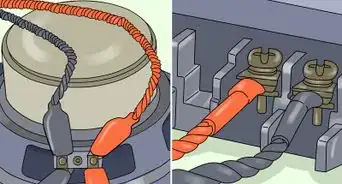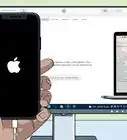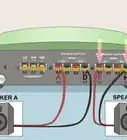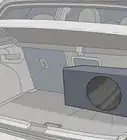This article was co-authored by wikiHow Staff. Our trained team of editors and researchers validate articles for accuracy and comprehensiveness. wikiHow's Content Management Team carefully monitors the work from our editorial staff to ensure that each article is backed by trusted research and meets our high quality standards.
This article has been viewed 388,082 times.
Learn more...
Bumping your favorite tunes in the summertime with the windows down can come at a cost. Speakers can blow out from the best audio systems over time. It depends on what you listen to and how loud you listen to it. Lots of bass heavy electronic music and rap are notorious for blowing out speakers at the right volume.
Steps
Listening for Damage
-
1Turn on the vehicle. Most vehicles need to be turned on for the audio system to play. Unless your car is particular, you won't need to fully start the engine, which would only waste gas.
-
2Insert a CD or mp3 device with a full sound range. Pick something that you play often in your car, so you know what to listen for. This will help you spot anything that sounds unusual. You could also pick a song that has a clear and familiar bass line.Advertisement
-
3Turn the volume to an appropriate level. If the audio is too low, it will be hard to tell if you have a blown speaker. This doesn't mean that you should blast your whole neighborhood with your tunes to diagnose your vehicle.
- Adjust the treble and bass, if necessary. Make sure that their levels are equal in the twelve o'clock position. When you hear a lack of range, it might just mean your system isn't equalized properly.[1]
-
4Recognize distortion. If you have trouble recognizing distortion, play a track on headphones or on another device. Then, play that same track through your car's sound system. If you hear crackles or the song sounds slightly muffled, one or more of your speakers might be blown.
- Listen for rattling. If the speaker is blown, you will likely hear a shaking, rattling sound.[2]
-
5Listen for a lack of range. If a certain bass, mid, or high speaker is blown, you will notice certain registers don't come through. This is easiest if you are familiar with the song, and know what to listen for or expect.[3]
-
6Isolate the speaker. If possible, use your audio system's fader controls to attempt to isolate the faulty speaker. By narrowing down one section of the car, you'll have a better chance of determining which speaker is blown. Always try to isolate the problem so you don't overspend and replace the entire system.[4]
- Use the pan function to switch the sound from left to right. When panning, go 100% to either the left or right side to fully isolate it.
- Use the fade settings the same as the pan setting. Go 100% to the rear or front of your car.
Testing Speaker Connections
-
1Remove the wires from the amplifier and attach them to a 9-volt battery. Listen out for a brief popping sound form the speaker.[5]
- This might require you to unscrew the speaker out of its holder.
- Only remove the wires if you're comfortable handling electronics.
-
2Inspect the speaker. Remove the speaker cover so you can inspect the speaker itself. Attach the wires to a 9-volt battery again and observe the speaker. If the cone moves, your problem is in the connection, not the speaker.[6]
-
3Get a multimeter tester. These simple electronic tools help measure ohms and voltages. They can be found at your local electronic store or hardware store.
- You can also use an ohmmeter.
-
4Test the ohms. Set your device to reading ohms if you're using a multimeter. Make sure that the speakers are turned off. Touch the lead of your device to each terminal of the speaker. The terminal is the part of the speaker where the wires attach.[7]
- If you get a reading of 1.0 ohms, then that speaker is not blown and the problem is somewhere else.
- If the device reads infinite ohms, then your speaker is blown.[8]
Testing the Amplifiers
-
1Understand how bad amplifiers can affect sound. If there is something wrong with the amplifier, you will likely hear some sound distortion when you turn on your speakers, or nothing at all. This is usually because there is something wrong with the fuse or the capacitor.
-
2Open the fuse box. If you don't know where the fuse box is, you can check online or in the manual that came with your car, as each car will be a little different. A fuse box will usually be located in the front of the knee-well or under the dashboard, however.[9]
-
3Get out your multimeter and set it to the conductivity test. This will help you figure out whether or not the fuse is good or needs
-
4Hook up the multimeter to the fuse box. Touch the multimeter's red wire to one of the poles on the fuse. Touch the meter's black wire to the other pole.
-
5Listen for any beeps. If you hear a beep, then the fuse is good, and your problem is likely with the capacitor. If you don't hear a beep, then the fuse is blown and needs to be replaced. Be sure to get the exact same fuse model.
- If you hear a beep, consider replacing the amp first. They are usually less expensive, and don't require soldering irons and desoldering pumps like new capacitors do.
-
6Turn on the car, and test the speakers. They should be working now. If they don't, then there might be something else wrong with your car's speakers. Consider taking your car in to the repair shop, and having a professional take a look at it.
Assessing the Damage
-
1Inspect the damage. Visually take a look at the speaker once you've determined the speaker is faulty. Look for holes, tears, or splits on the speaker. Make sure the cover of the speaker is off so you can truly inspect it. Most damage that you'll be able to see will be on the cone of the speaker, or the soft part.
- Gently run your hand along the cone to make sure there isn't any scrapes you can't see.
- Dust or dirt shouldn't affect the quality of the speaker, but it might be a good idea to clean them out.
-
2Repair minor damages. If you only have a small tear, you can fix the damages with a sealer designed for speakers. If the damage is overwhelming, you'll probably need to replace the speaker.
-
3Test the remaining speakers. Once you've determined one of your speakers is blown, you'll want to see if any of the other speakers are blown. Remove the faulty speaker, if you haven't already done so. Play a track in your car and listen for speaker irregularities.
- If the problem persists in multiple speakers, consider replacing the entire system.
- Follow the above steps to test any other suspicious speakers.
-
4Let the professionals look. Take your car or speaker to an automotive audio specialist. Explain the tests you gave and ask them what their estimate would be to inspect and repair the speaker or speakers. Be frank and ask if she thinks it'll be more price effective to replace the set.
Community Q&A
-
QuestionWhat are the chances of having a warranty on the speaker from the audio shop I bought the speakers from?
 Community AnswerTypically shops don't warranty their speakers. If you have a higher end brand, ask to see if it comes with a warranty through the brand itself. it also doesn't hurt to ask the shop if they do warranty their products. if you want to do it anonymously, call ahead and ask.
Community AnswerTypically shops don't warranty their speakers. If you have a higher end brand, ask to see if it comes with a warranty through the brand itself. it also doesn't hurt to ask the shop if they do warranty their products. if you want to do it anonymously, call ahead and ask. -
QuestionI have a 2002 Chrysler Town & Country; the front left speaker and the back speakers don't work. What should I do?
 Community AnswerIt's probably the head unit (radio). It could have failed, or maybe the wires are shorting out. If you can access the wires behind the head unit, check to see if they are all connected. If so, you will need to replace the radio.
Community AnswerIt's probably the head unit (radio). It could have failed, or maybe the wires are shorting out. If you can access the wires behind the head unit, check to see if they are all connected. If so, you will need to replace the radio. -
QuestionAll my speakers in my car work, except for the one on the right front door. What could be wrong?
 Community AnswerIt's probably a bad connection in the wiring. Blown speakers make a cracking type sound, like static.
Community AnswerIt's probably a bad connection in the wiring. Blown speakers make a cracking type sound, like static.
Warnings
- Always practice electrical safety.⧼thumbs_response⧽
- Never shove tools or other objects into a speaker that is still connected to power.⧼thumbs_response⧽
- Be careful about working on anything with an electrical charge to avoid injury.⧼thumbs_response⧽
Things You'll Need
- Multimeter tester
References
- ↑ http://www.joesstereo.com/signs-blown-car-speaker/
- ↑ http://knowledge.sonicelectronix.com/car-audio-and-video/car-speakers/facts-about-blown-speakers/
- ↑ http://knowledge.sonicelectronix.com/car-audio-and-video/car-speakers/facts-about-blown-speakers/
- ↑ https://us.en.kb.sony.com/app/answers/detail/a_id/39420/~/how-to-locate-static-or-sound-distortion-coming-from-car-speakers.
- ↑ http://www.autos.com/aftermarket-parts/how-to-tell-if-a-subwoofer-car-speaker-is-blown
- ↑ http://www.autos.com/aftermarket-parts/how-to-tell-if-a-subwoofer-car-speaker-is-blown
- ↑ http://www.autos.com/aftermarket-parts/how-to-tell-if-a-subwoofer-car-speaker-is-blown
- ↑ http://www.autos.com/aftermarket-parts/how-to-tell-if-a-subwoofer-car-speaker-is-blown
- ↑ http://www.howacarworks.com/accessories/checking-and-replacing-fuses
About This Article
To tell if your car speakers are blown, try playing a song through your headphones and then through your car's speakers to compare the sound quality. If the song sounds muffled or there's crackling coming from the speakers, one of your speakers is probably blown. Next, use your audio fader controls to find out which speaker is causing the problem. Turn your fader so the music only plays out of the speakers in the back, then switch to the front and listen for a change in sound quality. For tips on how to test your amplifier and how to repair limited damage to a speaker, read on!
